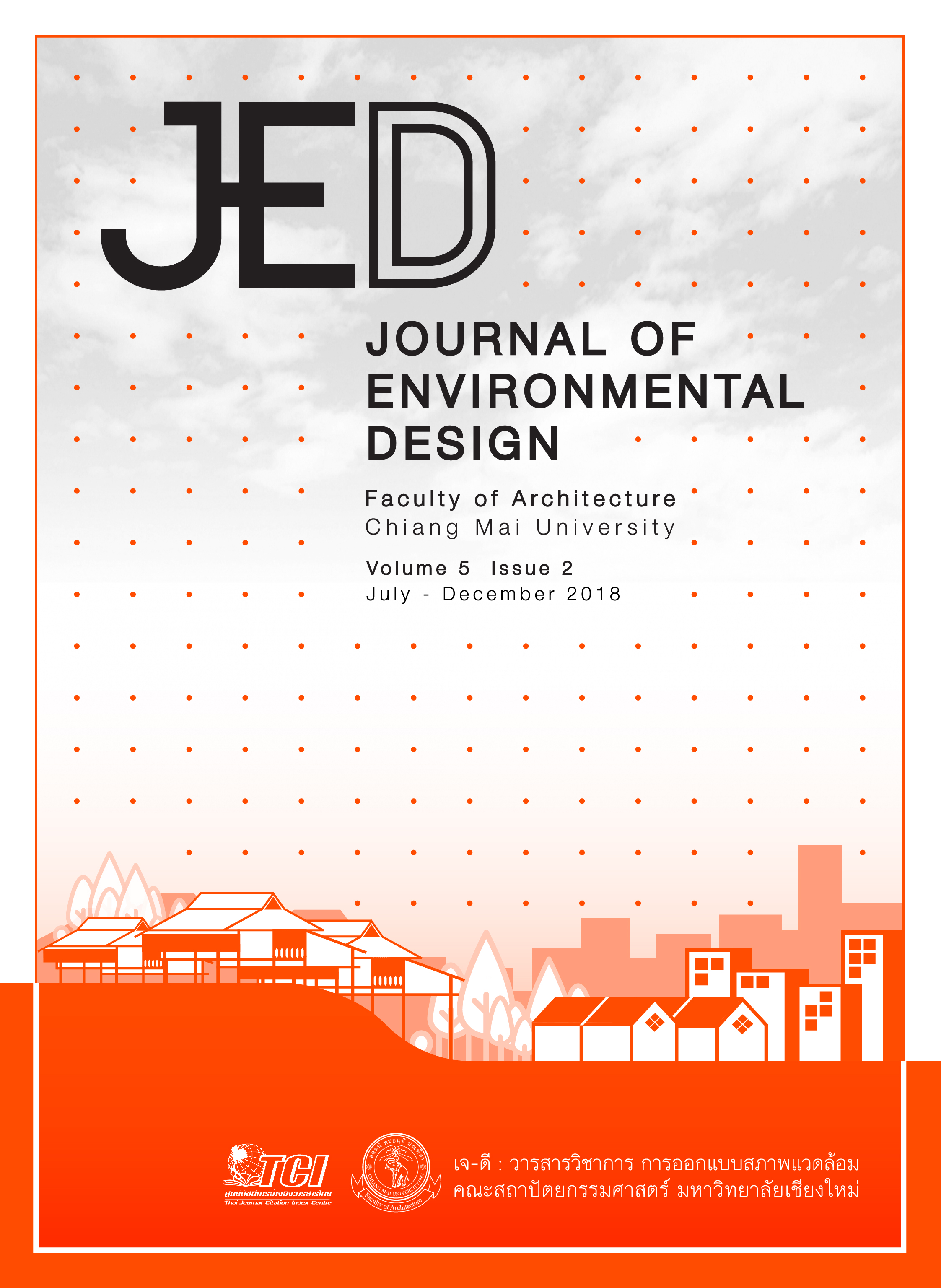บ้านอยู่ดี การบูรณาการเรียนรู้สถาปัตยกรรมผ่านโครงการบริการวิชาการรับใช้สังคม
Main Article Content
บทคัดย่อ
ศูนย์การเรียนรู้คนพิการและครอบครัวตามแนวพระราชดำริฯด้านเศรษฐกิจพอเพียง จังหวัดระยอง มีเป้าหมายในการส่งเสริมให้คนพิการมีอาชีพและรายได้ที่มั่นคงโดยไม่ต้องพึ่งพา แม้ว่าความต้องการของคนพิการในการมาทำงานและฝึกอาชีพเกษตรและปศุสัตว์ที่ศูนย์แห่งนี้จะมีมาก ศูนย์ฯไม่สามารถจัดเตรียมที่พักอาศัยรองรับได้เพียงพอ ด้วยความท้าทายนี้มหาวิทยาลัยกรุงเทพโดยคณะสถาปัตยกรรมศาสตร์อาสาร่วมกับศูนย์ฯในการจัดทำโครงการบ้านอยู่ดีเพื่อช่วยแก้ปัญหา โดยมีวัตถุประสงค์เพื่อบูรณาการโครงการบริการวิชาการรับใช้สังคมเข้ากับการเรียนรู้ทางการออกแบบสถาปัตยกรรม ซึ่งระหว่างดำเนินการ โครงการนี้ก่อให้เกิดการแลกเปลี่ยนเรียนรู้ระหว่างหลากหลายสาขา เช่น ด้านสถาปัตยกรรม กฎหมาย และความพิการ แนวคิดการออกแบบสถาปัตยกรรมและการออกแบบเพื่อทุกคนถูกนำมาศึกษา เพราะแนวคิดทั้งสองเกี่ยวข้องกับการออกแบบเพื่อผู้พิการโดยตรง จากนั้นแนวคิดการออกแบบอย่างมีส่วนร่วมได้ถูกนำมาประยุกต์ใช้ในแต่ละขั้นตอนของการดำเนินโครงการและกำหนดวิธีการวิจัย เนื่องด้วยการทำงานร่วมกันจากคนที่ต่างความเชี่ยวชาญในโครงการนี้เป็นสิ่งจำเป็น ในด้านการประเมินการเรียนรู้ นอกจากผู้สอนแล้วแต่ละขั้นตอนถูกประเมินโดยผู้ที่เกี่ยวข้องที่แตกต่างกัน เช่น คนพิการ ตัวแทนภาครัฐ และช่างก่อสร้าง เป็นต้น เหล่านี้ล้วนแล้วแต่เป็นประโยชน์ที่ได้จากการพบปัญหาจริง ซึ่งนักศึกษาสถาปัตยกรรมได้เรียนรู้จากความต้องการของผู้ใช้สอยจริงและจัดการกับบทเรียนด้านการออกแบบจนสำเร็จได้ด้วยประสบการณ์ถ่ายทอดจากของจริง
Article Details
เอกสารอ้างอิง
Center for Universal Design. (2008). About the center: Ronald L. Mace. Retrieved 7 February 2018 from https://projects.ncsu.edu/ncsu/design/cud/about_us/usronmace.htm.
Chutapruttikorn, R., Piya-Arun, K & Takulthongjaroen, P. (2015). Phaen yutthasat tam neawkid karn oak bab phuea thuk khon (in Thai) [Universal design strategic planning]. Bangkok: Bangkok University Printing Press.
Chutapruttikorn, R. & Rattakorn, V. (2013). Botbat khong sathaban karn sueksa lae chum chon nai kwam mee suanruam kab karn anurak moradok wattanatham. Koranee sueksa chumchon Mon Wat Saladang Neua. (in Thai) [A role of academic and community in participatory approach on cultural heritage conservation: a case study of chumchon Mon Wat Saladang Neua]. Proceedings of the ICOMOS Thailand: National conference 2013, Asian forgotten heritage: perception, preservation and presentation. Faculty of Architecture, Chiang Mai University, Chiang Mai 15-16 October 2003.
Johnson, D. & Johnson, R (2001). Karn rianru bab ruammue lae karn keakhai kwam Khatyang (in Thai) [Cooperative learning and conflict resolution]. Wongkijrungrueng, W. & Chitlerk, A. (Eds.). Taksa haeng anakot mai karn sueksa phuea satawat tee yi sib ed. (21st century skill rethinking how students learn), Bangkok: Openworlds.
International Union of Architect. (2014). UIA accord on recommended international standards of professionalism in architectural practice. Retrieved September 16th, 2018 from http://ethics.iit.edu/ecodes/sites/default/files/UIA%20Code%20of%20Ethics-Accord_0.pdf
Kittipanan. (2011). Chang phu phikarn tham ngan nueng tor roi kotmai roem sam sib tor kor. (in Thai) [1:100 disable people employment the beginning of law 30 October]. Retrieved February 8, 2018 from http://www.thaihealth.or.th/Content/4278.
Lee, Y. (2006). Design “Participation tactics: redefining user participation in design”. Paper presented at Design Research Society. Lisbon: IADE.
Patanapongsa, N. (2004). Karn mee suanruam lak karn phuenthan technique lae koranee tuayang. (in Thai) [Participation: basic principles, technical and case studies]. Chiang Mai: Sirirak Printing.
Pearlman, B. (2010). Designing new learning environments to support 21st century skills. In. Bellanca, J & Brandt, R. (Eds.), 21st century skills: rethinking how students learn (pp. 117–147). Bloomington: Solution Tree Press.
Preiser, W. & Ostroff, E. (2001). Universal design handbook. New York: McGraw-Hill.
Robinson, K. & Aronica, L. (2016). Creative schools: the grassroots revolution that’s transforming education. New York: Penguin Books.
Sanoff, H. (2000). Community participation methods in design and planning. Chichester: Wiley.
Sanoff, H. (2005). Community participation in riverfront development, Co Design, 1, (1), pp. 16-78.
Sthapitanonda, N. (2000). Ong prakob: sathapattayakum phuenthan. (in Thai) [Fundamental elements of architecture]. Bangkok: Chulalongkorn University.
Sodcharoen, C. (2013). Karn buranakarn nueaha klum sara karn rianru. (in Thai) [Integration of content in the subject matter]. Retrieved February 11, 2018 from https://www.gotoknow.org/posts/547039.
Wannasathit, C. (2015). Kotkrasuang kamnot sing amnuai kwam saduak nai arkan samrab phu phikarn rue phu thupponlaphap lae khon chara. (in Thai) [Ministerial regulations defining facilities for disabled persons and handicaps or elderly]. Retrieved February 4, 2018 from http://www.elevatordesigner.com/documents/04.pdf.


